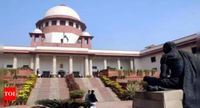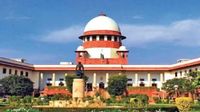NEW DELHI: In a significant ruling that underscores the importance of linguistic diversity in India, the Supreme Court upheld the use of Urdu on the signboard of the new Municipal Council building in Patur, Maharashtra, on April 15, 2025. This decision comes at a time when the nation grapples with language-related tensions, particularly in states like Maharashtra, where individuals have faced backlash for not speaking the local language.
The bench, comprising Justices Sudhanshu Dhulia and K Vinod Chandran, emphasized that language should serve as a bridge rather than a barrier, stating that it should not become a cause of division among communities. Justice Dhulia articulated, "Language is a medium for the exchange of ideas that brings people holding diverse views and beliefs closer and it should not become a cause of their division." This sentiment echoes a broader call for unity in diversity, a core principle of Indian society.
The signboard in question displays "Municipal Council, Patur" in Marathi at the top, with its Urdu translation beneath. The court dismissed a petition from Varshatai, a former member of the Municipal Council, who argued that the council's work should exclusively be conducted in Marathi and that the inclusion of Urdu was impermissible. The bench countered this claim, affirming that the display of an additional language does not violate the Maharashtra Local Authorities (Official Languages) Act, 2022, which does not prohibit the use of Urdu.
Justice Dhulia pointed out that the misconception surrounding Urdu as an alien language in India is fundamentally flawed. He stated, "Urdu, like Marathi and Hindi, is an Indo-Aryan language. It is a language that was born in this land." The court noted that Urdu has flourished in India as a means for people from diverse cultural backgrounds to communicate and share ideas, evolving into a language celebrated for its poetic heritage.
The Supreme Court's ruling also highlighted the historical significance of Urdu in the Indian linguistic landscape. According to the 2001 Census, Urdu ranks as the sixth most spoken scheduled language in India, with speakers in every state and Union Territory except for some in the northeastern region. The bench noted that the word "Hindi" itself traces its origins to the Persian term "Hindavi," illustrating the intertwined nature of these languages.
Justice Dhulia further explained that the fusion of Hindi and Urdu has historically faced challenges, particularly during colonial times when linguistic identities became politicized along religious lines. He remarked, "Hindi was now understood to be the language of Hindus and Urdu of the Muslims, which is such a pitiable digression from reality; from unity in diversity; and the concept of universal brotherhood." The court's ruling serves as a reminder that languages are not merely tools of communication but also reflect the cultural richness of a community.
The bench also pointed out that Urdu influences everyday language across India, stating, "It would not be incorrect to say that one cannot have a day-to-day conversation in Hindi without using words of Urdu or words derived from Urdu." This observation reinforces the idea that language is a living entity, constantly evolving through cultural exchange.
Moreover, the court recognized the role of Urdu in the legal system, noting that many legal terms in Indian courts are derived from Urdu. Words like "adalat" (court) and "halafnama" (affidavit) are part of the legal lexicon, showcasing Urdu's deep-rooted presence in India's judicial framework.
As the ruling reverberates through the corridors of power and society, it reiterates the need for a more inclusive approach to language in public life. The Supreme Court's decision to uphold the use of Urdu in Patur is not just about a signboard; it represents a broader commitment to embracing India's linguistic diversity and fostering a sense of belonging among all communities.
In addition to the ruling, the bench highlighted that several states, including Andhra Pradesh, Bihar, Jharkhand, Telangana, Uttar Pradesh, and West Bengal, have recognized Urdu as an official language. The Union Territories of Delhi and Jammu and Kashmir also follow this practice, exercising the powers conferred by Article 345 of the Indian Constitution, which allows states to adopt languages for official purposes.
Justice Dhulia's remarks resonate with the ongoing discourse around language in India. He urged society to confront its prejudices against languages like Urdu, stating, "Our misconceptions, perhaps even our prejudices against a language, have to be courageously and truthfully tested against the reality, which is this great diversity of our nation." This call to action invites citizens to embrace the richness of India's linguistic heritage rather than allowing it to become a source of division.
In summary, the Supreme Court's ruling on the use of Urdu in Patur is a landmark moment in the ongoing dialogue about language and identity in India. It reflects a commitment to celebrating the nation's diversity and recognizing the importance of all languages as vital components of India's cultural fabric. By acknowledging the historical and contemporary significance of Urdu, the court has reinforced the idea that language should unite rather than divide, echoing the fundamental ethos of India as a nation of many voices.





